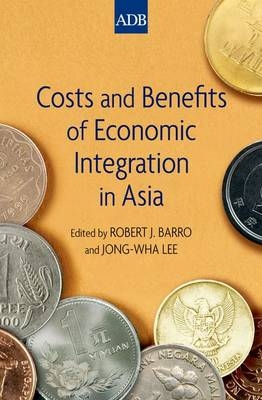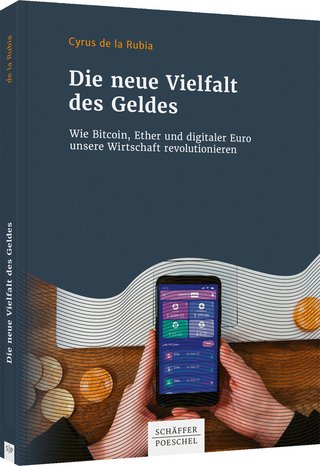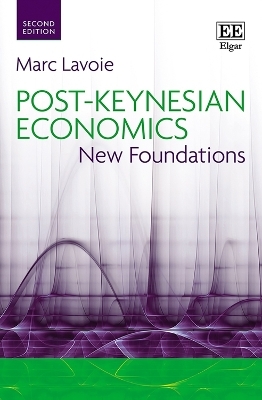
Costs and Benefits of Economic Integration in Asia
Oxford University Press Inc (Verlag)
978-0-19-975398-7 (ISBN)
To recover from recession, the global economy must rely on the strong performance of developing Asian economies, and it has become clear not only in Asia that regional cooperation and integration is key to regional economic development. Heavily reliant on external demand as an impetus to growth and closely linked to global financial markets, Asian economies are becoming closely integrated through trade, investment, and financial transactions. But how closely integrated are they, and what are the real benefits of integration?
In line with its goal to foster economic growth and cooperation in the region, the Asian Development Bank, with Robert J. Barro and Jong-Wha Lee, have collected a formidable group of scholars to tackle the issues related to these questions. Costs & Benefits of Economic Integration in Asia offers quantifiable results from the field's top economists on cooperation and integration in the areas of trade, investment, and finance in Asia. Appealing to scholars, policymakers, and interested general readers, the book is an authoritative diagnosis of initiatives seeking to promote regional economic integration. It examines two broad divisions of cooperation and integration: monetary and financial, and trade and investment. Specific enquiries include such topics as comparisons to other regions such as Eastern Europe and Latin America, the effects of regional free trade agreements on overall trade and welfare, the distribution of benefits of unevenly distributed resource wealth among the region's economies, the possibility and desirability of an East Asian currency union, business cycle synchronization and its relationship with inflation targeting regime and trade, pre-World War I Asian monetary systems, the computation of the extent of foreign and domestic content in a country's exports, and many more.
After financial disaster, the world's economy is changing drastically, and Asia will play a pivotal role in how these changes occur. Costs & Benefits of Economic Integration in Asia is an essential reference on the controversy and consensus on economic integration, and how it will influence individual Asian countries, the region as a whole, and the world, for decades to come.
Robert J. Barro is Paul M. Warburg Professor of Economics at Harvard University, a senior fellow of the Hoover Institution of Stanford University, and a research associate of the National Bureau of Economic Research. His recent books include Macroeconomics: A Modern Approach, Economic Growth, Nothing Is Sacred: Economic Ideas for the New Millennium, and Determinants of Economic Growth. Jong-Wha Lee is former Chief Economist and Head of the Office of Regional Economic Integration of the Asian Development Bank, and currently Professor at the Economics Department of Korea University. He has worked as an economist at the International Monetary Fund, taught at Harvard University as a visiting professor, and served as a consultant to various institutions such as the Harvard Institute for International Development, the Inter-American Development Bank, the United Nations Development Programme, and the World Bank.
Foreword ; Acknowledgements ; Contributors ; Acronyms ; I. Introductory Essay ; Robert J. Barro and Jong-Wha Lee ; II. East Asian Currency Union ; Jong-Wha Lee and Robert J. Barro ; 1. Introduction ; 2. The Benefits and Costs of an East Asian Currency Union ; 2.1 Benefits and Costs of Currency Unions ; 2.2 Optimum Currency Area (OCA) Criteria ; 3. Which Currency Union for East Asia? ; 3.1 Data for East Asia Monetary Union Analysis ; 3.2 Is East Asia an OCA? ; 4. Welfare Effects of East Asian Currency Unions ; 4.1 The Effects of Currency Unions on Growth and Volatility ; 4.2 Rare Disasters and Currency Unions ; 4.3 Estimation of Welfare Effects of East Asian Currency Unions: An Illustration ; 5. Concluding Remarks ; III. Asian Financial Integration: Trends and Interruptions ; Eduardo Borensztein and Prakash Loungani ; 1. Introduction ; 2. Convergence in Interest Rates and Equity Premia ; 3. Portfolio Holdings and Home Bias ; 3.1 Portfolio Holdings: Summary Statistics ; 3.2 Portfolio Holdings: Gravity Model Estimates ; 3.3 Home Bias ; 4. Risk-Sharing and Financial Stability ; 4.1 Risk-Sharing ; 4.2 Financial Integration and Crises ; 4.3 Local vs. Foreign Investors: Recent Studies ; 4.4 Investor Behavior during the Subprime Crisis: Evidence from Brazil ; 5. Conclusions ; IV. Understanding Business Cycle Synchronization: Is Inflation Targeting Paving the Way to Asian Monetary Union? ; Andrew K. Rose ; 1. Motivation and Introduction ; 2. The Effect of Trade on Business Cycle Synchronization ; 3. Inflation Targeting and Business Cycle Synchronization: Theory and Literature ; 4. The Data Set ; 5. Decoupling ; 6. Business Cycle Synchronization and Inflation Targeting ; 7. Regression Analysis ; 8. Estimating Treatment Effects via Matching ; 9. Why? ; 10. Summary and Conclusion ; V. Trading Silver for Gold: Nineteenth-Century Asian Exports and the Political Economy of Currency Unions ; Kris James Mitchener and Hans-Joachim Voth ; 1. Introduction ; 2. Historical Background and Context ; 3. Data ; 4. Method and Results ; 4.1 Multilateral Resistance ; 4.2 Results for Sub-Periods ; 4.3 Discussion ; 5. Identifying the Effects of Currency Choice ; 6. The Political Economy of Currency Arrangements ; 7. Conclusion ; VI. The ASEAN Free Trade Agreement: Impact on Trade Flows and External Trade Barriers ; Hector Calvo-Pardo, Caroline Freund and Emanuel Ornelas ; 1. Introduction ; 2. Trade Creation, Trade Diversion, and Import Barriers on Outsiders ; 3. The ASEAN Free Trade Agreement ; 3.1 Data ; 3.2 Tariffs ; 3.3 Aggregate Trade ; 4. The Effect of Tariffs on Trade in ASEAN ; 5. Preferences and External Tariffs in ASEAN ; 6. Conclusion ; VII. Economic Integration in Remote Resource-Rich Regions ; Anthony J. Venables ; 1. Introduction ; 2. Regional Characteristics ; 3. Trade Policy for Remote-Rich Economies ; 3.1 Low Supply Response of External Exports ; 3.2 The Distribution of Natural Resources ; 3.3 Regionally and Globally Traded Goods ; 4. A Benchmark Model ; 5. Trade Liberalizations ; 5.1 Trade Policy and the Intra-Regional Terms of Trade ; 5.2 Trade Policy: General Equilibrium Outcomes ; 5.3 Non-Resource Income and Within Country Income Distribution ; 5.4 Trade Creation and Trade Diversion ; 6. Policy Implications ; 7. Concluding Comments ; VIII. Regional Trade Integration and Multinational Firm Strategies ; Pol Antras and C. Fritz Foley ; 1. Introduction ; 2. A First Look at the Data ; 3. Theoretical Framework ; 3.1 A Simple Model of FDI ; 3.2 Analysis ; 3.3 Effects of a Regional Trade Agreement ; 4. Econometric Evidence ; 5. Conclusion ; IX. A World Factory in Global Production Chains: Estimating Imported Value-Added in Exports by the People's Republic of China ; Robert Koopman, Zhi Wang and Shang-Jin Wei ; 1. Introduction ; 2. Conceptual Framework and Estimation Method ; 2.1 When Special Features of Processing Exports Are Not Taken Into Account ; 2.2 Domestic Content in Exports When Processing Trade is Prevalent ; 2.3 Estimation Issues ; 3. Estimation Results on Domestic and Foreign Content in Exports of the PRC ; 3.1 Data ; 3.2 Domestic and Foreign Contents in Total Exports ; 4. Slicing Up the Value Chains along Multiple Countries: Methodology ; 4.1 When a World Input-Output Table (That Covers All Countries) is Available ; 4.2 Working with an Inter-Regional Input-Output Table (for a Subset of Countries) ; 5. Empirical Estimates on Value-Added Along Production Chains ; 5.1 Data Source ; 5.2 Comparing the PRC with Other Asian Economies in Production Chain ; 5.3 Slicing Up Production Chains Across Countries ; 5.4 Multinational Value-Added Chains in the PRC for Disaggregated Export Categories ; 6. Concluding Remarks
| Erscheint lt. Verlag | 3.2.2011 |
|---|---|
| Zusatzinfo | 35 b/w line |
| Verlagsort | New York |
| Sprache | englisch |
| Maße | 236 x 155 mm |
| Gewicht | 544 g |
| Themenwelt | Wirtschaft ► Volkswirtschaftslehre ► Finanzwissenschaft |
| Wirtschaft ► Volkswirtschaftslehre ► Makroökonomie | |
| ISBN-10 | 0-19-975398-9 / 0199753989 |
| ISBN-13 | 978-0-19-975398-7 / 9780199753987 |
| Zustand | Neuware |
| Haben Sie eine Frage zum Produkt? |
aus dem Bereich


